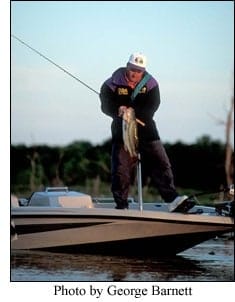When they asked me to write about some tactics for December, my first inclination was to wonder why I had to work with December and not a more exciting month like April or July. December can be full of variables and pinpointing one or two things that would help people all around the country can be a little difficult.
 So I decided to relate everything to Kentucky Lake. It’s a lake I enjoy fishing; a place where I spend a lot of time away from the tournament trail. Plus, Kentucky Lake being pretty much a mid-latitude reservoir, splits the difference between the two extremes of the country. It’s not like south Texas or Florida bass fishing in December, but we aren’t fishing out of icehouses, either. It can be cold, no doubt, but keeping an eye on the water temperature and not the air temperature can help you key in on two places to cash in on holiday bass.
So I decided to relate everything to Kentucky Lake. It’s a lake I enjoy fishing; a place where I spend a lot of time away from the tournament trail. Plus, Kentucky Lake being pretty much a mid-latitude reservoir, splits the difference between the two extremes of the country. It’s not like south Texas or Florida bass fishing in December, but we aren’t fishing out of icehouses, either. It can be cold, no doubt, but keeping an eye on the water temperature and not the air temperature can help you key in on two places to cash in on holiday bass.
Of course, the standard disclaimer applies: north of Kentucky Lake these changes will happen sooner in the year; south of Kentucky Lake will be later.
By December on Kentucky Lake, the bass have started setting up for their winter patterns. Here you will find them in the mid-creek range and the surrounding flats; maybe even in the creek channel swings – any place they can stay out of the main river channel and the current created by the dam pulling water to make electricity. What I am looking for above everything else is what the water temperature is doing. Depending on what the water temperature is, I will know what stage they are in: schooling (or suspending) or holding tightly to offshore structure. If the water temperature is anywhere in the low 60s to the mid 50s – which is where it is likely to be earlier in the month – I will set my sights on the schooling/suspended fish.
If these fish are schooling or suspended, they are naturally going to be oriented to looking up in the water column. So, I want a bait that will stay suspended above them. And I want to make sure they can see it. That’s why I will throw a white Gulp! Jerk Shad. I rig this bait on a 3/0 offset, round-bend hook and tie it to 15-pound Trilene 100% Fluorocarbon line. With a seven-foot, medium-heavy action Fenwick Techna AV rod topped with an Abu Garcia REVO STX, I will make a blind cast over the flats near creek channel swings and inside the mouths of creeks. I fish this bait slowly and allow the scent dispersion of the Gulp! bait to help trigger strikes. Plus, the white body helps bass visually key in on it when they are in deeper water. Giving the bait a few jerks to allow it to run a foot or two under water is the key.
But if the water temperature dips below the mid 50s, I know that the bass are pretty well into their winter patterns and will be holding close to underwater structure. This is where swimming a jig really shines. My jig size can vary from ¼-ounce to ¾-ounce depending on water temperature. The colder the water, the slower the fall I want my jig to have. With a ¼-ounce jig, I will tip it with a 3-inch, green pumpkin PowerBait Chigger Craw. For a ¾-ounce jig, I will go up to a 4-inch. Using the same rod-and-reel combo as with the Jerk Shad presentation and spooled with either 15- or 20-pound Trilene 100% Fluorocarbon line, I will begin to target bass around creek channel swings as well as in and around the mouths or creeks – wherever the last and deepest water is coming into the creek.
Looking at your electronics, you’ll see the not-so-subtle depth changes and breaks in these areas where depths go from four feet to 12 or eight feet to 20. These breaks will likely be rocky and have a more drastic depth change, and this is where the bass will be so that they can easily move up and down in the water column depending on the weather patterns and systems blowing through the area.
With the jig, my intent is to make contact with the bottom on the breaks and keep it about a foot off the bottom, letting it fall most of the time. Remember that colder water requires a slower fall and that if you aren’t within a foot or so of the bottom, you aren’t giving the fish a chance to strike.
So maybe December’s not such a bad month after all: schooling fish, throwing a jig around. And even though it’s cold, at least on Kentucky Lake we don’t have to drill holes in the ice.



